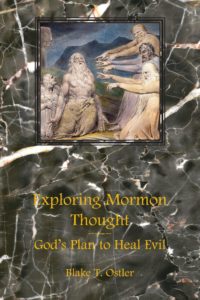 Title: Exploring Mormon Thought: Volume 4, God’s Plan to Heal Evil
Title: Exploring Mormon Thought: Volume 4, God’s Plan to Heal Evil
Author: Blake T. Ostler
Publisher: Greg Kofford Books
Genre: Theology
Year Published: 2020
Binding: ebook
Reviewed by Doug Gibson
It’s difficult to blend the “good news” of the Gospel of Christ with evil. Evil is the opposite of righteousness. Yet it will not discriminate the wicked from the faithful. Evil can cause us to doubt our creator’s divinity, his powers and his consistency. Its residual effects can lead to permanent discouragement, bitterness, and apostasy.
In contrast, others can use their faith to endure evil, and even strengthen their beliefs.
How can we explain evil? Or more so, how can we place evil in a plan of a benevolent God? Blake T. Ostler, author of the Exploring Mormon Thought series for Greg Kofford Books, has written the fourth volume, God’s Plan to Heal Evil (2020). (Here are purchase links to Greg Kofford Books and Amazon.)
Examples of evil include the murder of a young child, senseless deaths due to accidents, and examples of disease causing lives to end prematurely. As a father who helplessly held his infant son as he died — due to an imperfect heart — soon after birth, I can understand this as evil. Evil moves from a theory to be discussed to a unique, deeply personal experience, when one suffers from it.
Ostler addresses this question: how powerful can God be if he allows evil? All of us have heard the phrase, “it’s God’s will.” Or we have heard that “God respects natural law,” so evil has to occur. These are well-meaning arguments that anyone who has experienced will hear. But are they are inconsistent statements, more platitudes than explanations?
God’s power may only be persuasive, and not definitive. If so, prayer is essential.
But how consistent is God if he allows countless innocents to suffer evil while sparing others the same fate through “miracles?” Some miracles are related in the Scriptures; others by well-meaning but insensitive individuals thanking God for providing a miracle that spared them death or other adversity. The question can develop: why are they favored, and not me or my family? Is that really God’s plan?
Ostler’s solution to these seeming inconsistencies — which he does not regard as reasons to doubt God — is to turn evil into love. As followers of the Gospel who are on a path to becoming like God, we must learn “the kind of love that commands us to love our enemies.” We need to repay evil with love, the author asserts. It’s part of our life-on-earth contract that we consent to suffer the consequences of evil and work to turn the adversity into love.
Ostler writes: “… we must elicit love both for and from those who carry out such evils …” He uses Christ’s Sermon on the Mount as an example of this theology. “… Love your enemies, bless them that curse you, do good to them that hate you, and pray for them which despitefully use you, and persecute you; …”
God wants us to have a fulfilling and challenging life, Ostler writes. We are asked to progress spiritually through life. Turning evil into love is a challenge, but — as the author notes — we have divine assistance. Angels are on earth, ready to help us achieve the spiritual strength necessary to heal evil and turn it into a positive spiritual force.
This concept reminds me of C.S. Lewis’ book, The Great Divorce, in which “The Teacher,” guiding the narrator through his tour to the outskirts of heaven, says: “They say of some temporal suffering, ‘No future bliss can make up for it,’ not knowing that Heaven, once attained, will work backwards and turn even that agony into a glory.”
Turning “agony into a glory” captures the theme of Ostler’s God’s Plan to Heal Evil. Placing that theme in the context of Mormonism provides an opportunity for that to be accomplished on earth. Learning to love like God loves is part of our learning process toward divinity.
A final note: There is a lot of valuable information in God’s Plan to Heal Evil. I recommend it. But be patient with the writing. It is dense, thick writing, to a fault. I fear that may stifle readers. But persevere through the text; perhaps limit reading to 10, 20 pages a day. And buy a dictionary. It’s worth the read.
